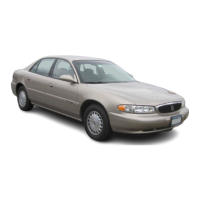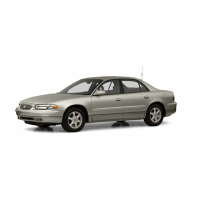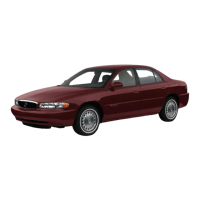
Do you have a question about the Buick 2007 Terraza and is the answer not in the manual?
| Brand | Buick |
|---|---|
| Model | 2007 Terraza |
| Category | Automobile |
| Language | English |
Details on manual and power seat adjustments, including heating and memory functions.
Guidance on proper safety belt usage, importance, and how they work.
Instructions on using safety belts for older children and infants/young children.
Explains airbag locations, deployment, and interaction with safety belts.
Details on locking mechanisms, power locks, and security features.
Guidance on new vehicle break-in, ignition positions, and starting the engine.
Services offered by OnStar®, including emergency and convenience features.
Explanation of the hazard warning system and its operation.
Details on operating turn signals, headlamps, wipers, and washers.
How to use, set, and cancel cruise control for speed management.
Details on gear selection, parking, and shifting procedures.
Overview of the vehicle's gauges, indicators, and warning lights.
Explanation of how to read vehicle speed and distance traveled.
Description of the safety belt reminder system and its function.
Information on the system that reminds the front passenger to buckle up.
Indicates the status of the airbag system's electrical components.
Shows whether the passenger airbag is enabled or disabled based on occupant detection.
Warning light indicating potential issues with the vehicle's charging system.
Alerts the driver to potential problems with the hydraulic brake system.
Indicates a malfunction in the Anti-lock Brake System (ABS).
Alerts the driver to issues with the traction control system.
Displays the engine's coolant temperature, warning of overheating.
The "Check Engine Light" indicates potential issues with engine, fuel, or emission systems.
Warns of low engine oil pressure, potentially causing engine damage.
Indicates the amount of fuel remaining in the tank.
Illuminates when the fuel tank is low on fuel.
Provides vehicle status, warnings, and system information.
How to navigate and use the DIC to view various vehicle data.
Explains various messages displayed by the DIC to notify the driver.
Overview of the vehicle's audio system, radio, and CD player features.
Details on operating the radio and CD player, including Radio Data System (RDS).
How to operate the radio, including volume and station selection.
Instructions for inserting and playing discs in the CD/DVD player.
How to stop, resume, or eject discs from the player.
Identification and function of the DVD player's controls.
Guide to using the remote control and on-screen menus for the RSE system.
Description of the wireless game controller and its buttons.
Safety compliance information for the wireless game controller.
Proper handling and care instructions for the DMS cartridge.
Common problems and their solutions for the digital media system.
How to use audio controls located on the steering wheel.
Techniques for anticipating and reacting to unexpected driving situations.
Information on the dangers of alcohol impairment and driving.
Explanation of the three systems (brakes, steering, accelerator) that control vehicle movement.
Factors affecting stopping distance and reaction time.
How the ABS system works to prevent braking skids.
Operation of the traction control system to limit wheel spin.
How StabiliTrak® helps maintain directional control through advanced systems.
Actions to take when experiencing a loss of vehicle control.
Understanding different types of skids and how to handle them.
Precautions and advice for driving in wet weather conditions.
Precautions and techniques for driving safely on snow and ice.
Guidelines for determining and adhering to vehicle weight limits.
General information and considerations for towing your vehicle.
Safety rules and tips for towing a trailer with your vehicle.
Precautions for driving with a trailer, including carbon monoxide risks.
Safety instructions and procedures for refueling the vehicle.
General precautions and warnings when inspecting under the hood.
Information on checking and maintaining engine oil levels.
Step-by-step instructions for checking the engine oil level.
How the system monitors and indicates when engine oil needs changing.
Information on checking and changing automatic transaxle fluid.
Detailed instructions for checking automatic transaxle fluid levels.
Information about the vehicle's engine coolant and its properties.
How to identify and respond to engine overheating conditions.
Safety precautions if steam is observed from the engine.
How the system protects the engine during overheating and driving recommendations.
Correct type of brake fluid to use and warnings about contamination.
How to identify worn brake pads and related issues.
Safely jump-starting your vehicle's battery.
Inspection and replacement of windshield wiper blades.
Information on tire quality, warranty, and maintenance.
Importance of correct tire pressure and potential issues with under/over-inflation.
Recommended intervals and procedures for tire inspection and rotation.
What to expect and do in the event of a tire blowout or flat.
Safety procedures for changing a flat tire.
Process for removing a flat tire and installing the spare tire.
Recommended methods for cleaning interior surfaces like fabric and plastic.
How fuses and circuit breakers protect wiring circuits.
Necessity of following prescribed maintenance for good condition and warranty.
Details on services performed at indicated maintenance intervals.
Specific services required at various mileage intervals.
Owner-performed checks and services for safety and dependability.
A list of recommended fluids and lubricants for your vehicle.
Steps to follow for resolving concerns with dealerships or GM.
Details on services provided by the Roadside Assistance program.
How vehicle computer systems collect and store data, including crash events.
Recommendations for repairing collision damage using qualified technicians and parts.
Steps to take and information to gather after an accident.
Procedures for reporting safety defects to government agencies and GM.
How to inform NHTSA about potential vehicle safety defects.
How to inform Transport Canada about potential vehicle safety defects.












